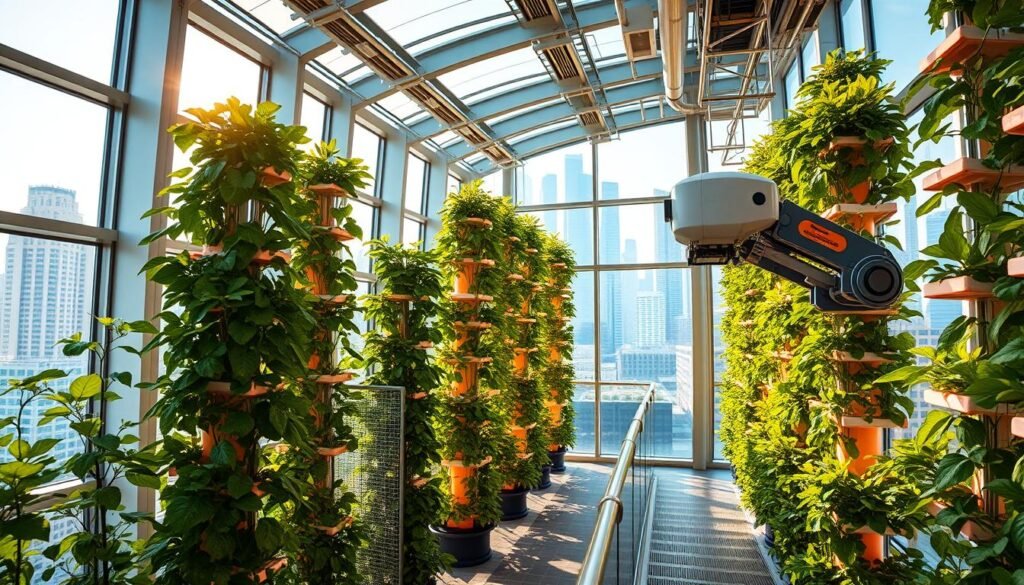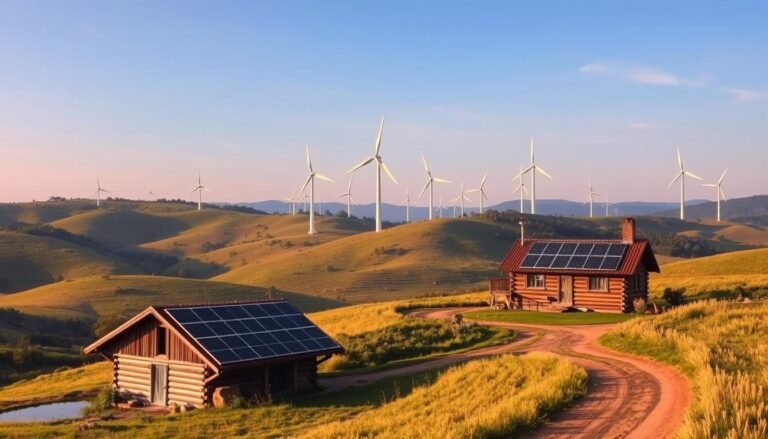The world is facing a significant challenge: feeding nearly 10 billion people by 2070 while minimizing the environmental impacts of food production.
To achieve this, the agricultural sector must adopt eco-friendly practices and leverage agri-tech green solutions to produce 40% more calories sustainably.
The role of green technology is crucial in addressing the challenges faced by the agricultural sector, ensuring a food-secure future.
Key Takeaways
- Increasing global food demand requires sustainable agricultural practices.
- Adopting eco-friendly technologies is crucial for minimizing environmental impacts.
- Agri-tech green solutions can significantly enhance food production.
- Green technology innovations are vital for a sustainable agricultural future.
- Efficient use of resources is key to feeding the world’s growing population.
The Global Food Security Challenge
Global food security is under threat as the world’s population is projected to reach 10 billion by 2070. This significant increase in population puts immense pressure on the agricultural sector to produce more food sustainably.
Population Growth and Food Demand
The relationship between population growth and food demand is direct: as the population grows, so does the demand for food. This increasing demand necessitates a significant boost in food production.
Current Statistics and Future Projections
Currently, the world produces enough food to feed everyone, yet millions still go hungry due to issues like food distribution and waste. Projections indicate that by 2050, we will need to produce 50% more food to meet the demands of the growing population.
Australia plays a crucial role in global food production, being one of the world’s largest exporters of agricultural products. The country’s ability to innovate and adopt sustainable agricultural practices will be vital in meeting future food demands.
Innovation in sustainability is key to addressing the global food security challenge. By adopting cutting-edge technologies and sustainable practices, countries like Australia can significantly contribute to feeding the world’s growing population.
Understanding Green Technology Innovations in Agriculture
Green technology innovations are transforming the agricultural sector by promoting sustainable practices and reducing environmental impact. This transformation is crucial for meeting the global food demand while minimizing the ecological footprint of farming activities.
Defining Sustainable Agriculture
Sustainable agriculture refers to farming practices that prioritize environmental stewardship, social responsibility, and economic viability. It involves the use of techniques that conserve natural resources, minimize waste, and promote biodiversity.
The Evolution of Agricultural Technology
Agricultural technology has evolved significantly over the years, from simple tools to complex machinery and digital systems. The latest advancements in green agri-tech are focused on precision farming, renewable energy, and sustainable practices.
Key Principles of Green Agri-Tech
Green agri-tech is guided by several key principles, including:
- Resource Efficiency: Maximizing output while minimizing input resources.
- Environmental Protection: Reducing the environmental impact of farming activities.
- Economic Viability: Ensuring that farming practices are economically sustainable.
Resource Efficiency
Resource efficiency is critical in green agri-tech, involving the optimal use of water, fertilizers, and other inputs to minimize waste.
Environmental Protection
Environmental protection is another key principle, achieved through practices like organic farming, conservation tillage, and integrated pest management.
Economic Viability
Economic viability is essential for the long-term sustainability of farming operations, achieved through efficient practices and market-driven approaches.
Precision Agriculture Technologies
Precision agriculture technologies are transforming the Australian farming landscape. By leveraging advanced tools like GPS and GIS mapping systems, farmers can optimize crop yields and reduce waste.
GPS and GIS Mapping Systems
GPS and GIS mapping systems are crucial components of precision agriculture. GPS technology allows for accurate positioning and navigation, while GIS mapping enables the analysis and visualization of spatial data. Together, they help farmers make informed decisions about planting, irrigation, and harvesting.
- Improved crop monitoring
- Enhanced soil analysis
- Optimized irrigation management
Variable Rate Technology
Variable Rate Technology (VRT) is another key aspect of precision agriculture. It involves adjusting the rate of inputs such as fertilizers and pesticides based on the specific needs of different areas within a field. This approach not only reduces waste but also minimizes environmental impact.
Benefits of VRT include:
- Increased efficiency
- Reduced chemical usage
- Improved crop yields
Australian Adoption of Precision Farming
Australia has been at the forefront of adopting precision agriculture technologies. The country’s vast agricultural lands and diverse farming practices make it an ideal location for the implementation of these innovations.
Case Study: Precision Agriculture in the Murray-Darling Basin
The Murray-Darling Basin is one of Australia’s most significant agricultural regions. A case study on the adoption of precision agriculture in this area highlights the benefits of these technologies, including improved water management and increased crop productivity.
The integration of precision agriculture technologies in the Murray-Darling Basin has led to more efficient farming practices and better resource management. As the agricultural sector continues to evolve, the adoption of these technologies is expected to play a crucial role in ensuring sustainable food production.
Smart Irrigation and Water Management
Australian farmers are increasingly turning to smart irrigation to conserve water and improve crop yields. This approach is crucial in addressing the challenges posed by climate change and water scarcity.
Sensor-Based Irrigation Systems
Sensor-based irrigation systems are at the forefront of smart irrigation technology. These systems use soil moisture sensors to monitor the water needs of crops in real-time, ensuring that water is applied precisely when and where it’s needed. This not only reduces water waste but also enhances crop health and productivity.
Drip Irrigation Advancements
Drip irrigation has seen significant advancements in recent years, with modern systems offering greater efficiency and flexibility. By delivering water directly to the roots of plants, drip irrigation minimizes evaporation and runoff, making it an ideal solution for water-conscious farmers. For more information on drip irrigation and other water-saving technologies, visit Water Tech: Smart Irrigation Technologies for Sustainable.
Water Conservation Strategies for Australian Farms
Adopting water conservation strategies is vital for the sustainability of Australian farms. Techniques such as mulching, cover cropping, and crop rotation can significantly reduce water usage. Additionally, implementing sensor-based irrigation systems and drip irrigation can lead to substantial water savings.
Addressing Water Scarcity in Drought-Prone Regions
In drought-prone regions, addressing water scarcity requires a multi-faceted approach. Farmers can benefit from implementing drought-resistant crop varieties and leveraging technologies like precision irrigation. The table below outlines some key strategies and their benefits.
| Strategy | Benefits |
|---|---|
| Sensor-Based Irrigation | Real-time monitoring, reduced water waste |
| Drip Irrigation | Water delivery directly to roots, minimized evaporation |
| Drought-Resistant Crops | Improved crop survival, reduced yield loss |
By embracing smart irrigation and water management practices, Australian farmers can not only enhance their resilience to climate change but also contribute to a more sustainable agricultural sector.
Renewable Energy in Farming
Renewable energy is revolutionizing farming practices in Australia, promoting eco-friendly technologies and energy independence. As the agricultural sector continues to evolve, the adoption of renewable energy sources is becoming increasingly important for sustainable farming.
Solar-Powered Agricultural Systems
Solar power is being harnessed on Australian farms to reduce reliance on fossil fuels. Solar-powered irrigation systems and farm equipment are becoming more common, providing a cleaner and more cost-effective alternative.
Wind Energy Applications
Wind energy is another significant source of renewable energy being utilized in Australian agriculture. Wind turbines are being installed on farms to generate electricity, reducing energy costs and carbon emissions.
Bioenergy Production on Farms
Bioenergy production involves converting organic matter into energy, providing a sustainable solution for farm waste management. This process not only generates renewable energy but also produces valuable by-products.
Energy Independence for Rural Australian Communities
A key benefit of renewable energy in farming is the potential for energy independence, particularly for rural communities. By generating their own energy, farmers can reduce their reliance on the grid and enhance their energy security.
| Renewable Energy Source | Application in Farming | Benefits |
|---|---|---|
| Solar Power | Irrigation Systems, Farm Equipment | Reduced Energy Costs, Lower Carbon Emissions |
| Wind Energy | Electricity Generation | Energy Independence, Reduced Operational Costs |
| Bioenergy | Waste Management, Energy Production | Sustainable Waste Disposal, Additional Income Streams |
The adoption of renewable energy in farming is a significant step towards a more sustainable agricultural sector. As technology continues to evolve, we can expect to see even more innovative applications of renewable energy in Australian farming.
Vertical Farming and Controlled Environment Agriculture
In Australian cities, vertical farming and controlled environment agriculture are emerging as key players in sustainable food systems. These innovative approaches to agriculture are not only enhancing food security but also contributing to more efficient use of resources.

Indoor Farming Technologies
Indoor farming technologies are at the forefront of vertical farming, allowing for crops to be grown in controlled environments. This method reduces the need for pesticides and other chemicals, resulting in cleaner produce. LED lighting plays a crucial role in these systems, providing the necessary spectrum for plant growth while minimizing energy consumption.
Key benefits of indoor farming include:
- Increased crop yields due to controlled conditions
- Reduced water usage through efficient irrigation systems
- Year-round production regardless of external weather conditions
Hydroponic and Aeroponic Systems
Hydroponic and aeroponic systems are integral to many vertical farming operations. Hydroponics involves growing plants in a nutrient-rich solution rather than soil, while aeroponics takes this a step further by delivering nutrients directly to the roots via a fine mist. Both methods offer significant water savings compared to traditional farming practices.
“The adoption of hydroponics and aeroponics in vertical farming represents a significant step forward in our quest for sustainable agriculture. These systems not only reduce water usage but also increase crop yields and quality.”
Urban Agriculture Initiatives in Australian Cities
Australian cities are embracing urban agriculture through various initiatives. Vertical farming and controlled environment agriculture are being integrated into urban landscapes, providing fresh produce to local communities.
Sydney and Melbourne’s Urban Farming Projects
Sydney and Melbourne are at the forefront of urban farming projects. In Sydney, initiatives such as the Sydney Vertical Farm are pioneering the use of advanced hydroponic systems to grow a wide range of crops. Melbourne, on the other hand, has seen a rise in rooftop gardens and indoor farming ventures, contributing to the city’s food security and sustainability goals.
These urban agriculture initiatives not only provide fresh produce but also serve as educational hubs, raising awareness about sustainable farming practices among city dwellers.
Sustainable Soil Management Technologies
Innovations in sustainable soil management are transforming the way we approach agriculture, enhancing both productivity and environmental stewardship. By leveraging cutting-edge technologies, farmers can improve soil health, reduce erosion, and promote carbon sequestration.
Soil Health Monitoring Tools
Soil health monitoring tools are crucial for understanding the complex dynamics of soil ecosystems. These tools enable farmers to make informed decisions about soil management practices. For instance, advanced sensors can measure soil moisture, temperature, and nutrient levels in real-time, allowing for precision agriculture practices that minimize waste and maximize yields.
Biochar and Carbon Sequestration
Biochar, a form of carbon-rich charcoal, is being increasingly used to enhance soil fertility and sequester carbon. By incorporating biochar into agricultural soils, farmers can improve soil structure, increase water retention, and reduce the need for synthetic fertilizers. This practice not only enhances soil health but also contributes to climate change mitigation by sequestering carbon.
“The use of biochar in agriculture represents a significant opportunity for carbon sequestration and improved soil health.”
Regenerative Agriculture Practices
Regenerative agriculture focuses on regenerating soil health through practices like minimal tillage, cover cropping, and crop rotation. These practices enhance soil biodiversity, improve soil carbon, and promote ecosystem services.
Building Soil Carbon in Australian Farmlands
Australian farmers are adopting regenerative practices to build soil carbon. A case study from Western Australia demonstrates that by using cover crops and reducing tillage, farmers can increase soil carbon by up to 20%. This not only improves soil health but also enhances farm resilience to climate change.
| Regenerative Practice | Impact on Soil Carbon | Additional Benefits |
|---|---|---|
| Minimal Tillage | Increased soil carbon | Reduced erosion, improved soil structure |
| Cover Cropping | Enhanced soil carbon sequestration | Improved soil health, increased biodiversity |
Indigenous Knowledge and Modern Green Technology
Indigenous knowledge is playing a crucial role in shaping sustainable agricultural practices in Australia through its integration with modern green technology. For centuries, Aboriginal communities have developed farming practices that are deeply connected to the land and its rhythms.
Traditional Aboriginal Farming Practices
Traditional Aboriginal farming practices are characterized by a deep understanding of the ecosystem and a holistic approach to land management. Techniques such as crop rotation, permaculture, and the use of native plant species have been employed to maintain soil fertility and biodiversity. These methods not only ensure sustainable food production but also preserve the cultural heritage of Aboriginal communities.
Integrating Indigenous Knowledge with Modern Innovation
The integration of indigenous knowledge with modern innovation is leading to the development of more sustainable and productive farming practices. By combining traditional techniques with modern eco-farming technologies, farmers can improve crop yields while minimizing environmental impact. This fusion of old and new approaches is particularly evident in areas such as precision agriculture, where indigenous knowledge informs the use of technology to optimize resource use.
Collaborative Research Projects in Australia
Several collaborative research projects in Australia are focused on integrating indigenous knowledge with modern green technology. These projects bring together researchers, farmers, and Aboriginal communities to develop and implement sustainable agricultural practices. By working together, these stakeholders can create innovative solutions that benefit both the environment and local communities.
The collaboration between indigenous knowledge holders and modern technologists is a promising avenue for achieving sustainable agricultural development in Australia. As the country continues to face environmental challenges, the integration of traditional practices with modern innovation will be crucial in building a more resilient and sustainable food system.
Biotechnology and Genetic Innovations
The future of Australian agriculture is being shaped by cutting-edge biotechnology and genetic innovations. These advancements are crucial in addressing the challenges faced by the agricultural sector, including climate change, pests, and diseases.
CRISPR and Gene Editing in Crops
CRISPR technology has emerged as a powerful tool in gene editing, allowing for precise modifications to crop genomes. This technology holds promise for developing crops that are more resilient to environmental stresses and diseases.

Drought and Disease Resistant Varieties
One of the significant applications of biotechnology in agriculture is the development of crop varieties that are resistant to drought and diseases. These varieties can significantly improve crop yields and reduce the reliance on chemical pesticides and irrigation.
| Crop | Trait | Benefit |
|---|---|---|
| Wheat | Drought Resistance | Improved yield in dry conditions |
| Cotton | Disease Resistance | Reduced pesticide use |
Ethical Considerations and Regulations in Australia
The use of biotechnology and genetic innovations in agriculture raises ethical considerations and is subject to regulatory oversight in Australia. Ensuring that these technologies are used responsibly is crucial.
Public Perception and Acceptance
Public perception and acceptance of genetically modified crops vary widely. Education and transparent communication about the benefits and risks of these technologies are essential for fostering public trust.
Robotics and Automation in Farming
Robotics and automation are transforming the face of farming in Australia, addressing labour shortages and improving crop yields. This technological advancement is crucial for the sustainability and productivity of the agricultural sector.
Autonomous Tractors and Harvesters
The introduction of autonomous tractors and harvesters is a significant step forward in farming technology. These machines can operate with precision, reducing the need for manual labour and increasing efficiency. For instance, autonomous tractors can work around the clock, optimizing planting and harvesting schedules.
Drones for Crop Monitoring
Drones equipped with advanced sensors and cameras are being used for crop monitoring, allowing farmers to assess crop health, detect pests, and identify areas that require irrigation. This technology enables early intervention, reducing crop loss and improving yields.
Robotic Weeding and Harvesting Systems
Robotic systems are being developed for weeding and harvesting, tasks that are typically labour-intensive. These robots can identify and remove weeds, reducing the need for herbicides, and can harvest crops with precision, minimizing damage and loss.
Labour Shortages and Automation Solutions
Labour shortages have long been a challenge for the agricultural sector. Automation solutions, including robotics, are providing a viable answer to this issue. By automating tasks such as planting, weeding, and harvesting, farmers can maintain productivity levels despite labour constraints.
The future of farming in Australia looks promising with the continued adoption of robotics and automation. As technology advances, we can expect to see even more innovative solutions that will further enhance the efficiency and sustainability of the agricultural industry.
- Increased efficiency through precision farming
- Reduced labour costs and dependency
- Improved crop yields and quality
As the agricultural sector continues to evolve, the integration of robotics and automation will play a pivotal role in shaping its future.
Artificial Intelligence and Big Data in Agriculture
Artificial intelligence and big data are playing a crucial role in modernizing Australian agriculture. By leveraging these technologies, farmers can make more informed decisions, improve crop yields, and reduce waste.
Predictive Analytics for Crop Management
Predictive analytics is being used to forecast crop yields, detect potential issues, and optimize farming practices. This involves analyzing historical data, weather patterns, and soil conditions to predict future outcomes.
Benefits of Predictive Analytics:
- Improved crop yields
- Reduced waste
- Enhanced decision-making
Machine Learning Applications
Machine learning algorithms are being applied to analyze data from various sources, including sensors, drones, and satellite imagery. This helps farmers identify patterns and trends that can inform their farming practices.
For instance, machine learning can be used to detect early signs of disease or pests, allowing farmers to take timely action.
Data-Driven Decision Making for Farmers
Data-driven decision making is becoming increasingly important in agriculture. By analyzing data from various sources, farmers can gain insights into their farming practices and make informed decisions.
Australian AgTech Startups and Innovations
Australia is home to a growing number of AgTech startups that are developing innovative solutions for farmers. These startups are leveraging artificial intelligence, big data, and other technologies to improve farming practices.
| Startup | Innovation | Benefit |
|---|---|---|
| FarmWise | AI-powered farming equipment | Improved crop yields |
| DataFarming | Data analytics platform | Enhanced decision-making |
By embracing artificial intelligence and big data, Australian farmers can improve their productivity, reduce their environmental impact, and contribute to a more sustainable food system.
Consumer Trends and Market Demand for Sustainable Produce
As consumers become more environmentally conscious, the demand for sustainably produced food is growing rapidly. This shift in consumer behavior is significantly influencing the agricultural sector, driving the adoption of sustainable practices and technologies.
Changing Consumer Preferences
Consumers are increasingly seeking produce that is not only fresh and healthy but also sustainably grown. This change in preference is pushing farmers and agricultural businesses to adopt eco-friendly farming techniques and technologies.
Certification and Traceability Technologies
To meet the growing demand for sustainable produce, certification and traceability technologies are becoming crucial. These technologies help in verifying the sustainability credentials of produce, thereby building consumer trust. Blockchain technology is one such innovation being used to enhance traceability.
Export Opportunities for Australian Sustainable Agriculture
Australian farmers and agricultural businesses are well-positioned to capitalize on the global demand for sustainable produce. By leveraging certification and traceability technologies, they can access new export markets, enhancing their competitiveness in the global arena.
Circular Economy in Agriculture
The circular economy is revolutionizing Australian agriculture by reducing waste and enhancing sustainability. This approach is crucial in transforming the agricultural sector into a more resilient and environmentally friendly industry.
One of the key aspects of the circular economy in agriculture is the implementation of waste-to-resource technologies. These technologies enable farmers to convert waste into valuable resources, thereby reducing environmental impact. For instance, organic waste can be composted and used as fertilizer, improving soil health and reducing the need for synthetic fertilizers.
Byproduct Utilization Systems
Byproduct utilization systems are another vital component of the circular economy in agriculture. These systems involve finding alternative uses for byproducts that would otherwise be considered waste. For example, straw and other crop residues can be used for animal bedding or bioenergy production, adding value to what would otherwise be waste.
Closed-Loop Farming Models
Closed-loop farming models aim to create a self-sustaining farming system where resources are cycled back into the farm. This approach not only reduces waste but also enhances the overall efficiency of the farm. Reducing food waste is a critical aspect of this model, achieved through technologies that improve supply chain management and predict consumer demand more accurately.
Reducing Food Waste Through Technology
Technologies such as predictive analytics and IoT sensors play a significant role in reducing food waste. By accurately predicting demand and monitoring storage conditions, farmers and distributors can minimize losses. This not only saves resources but also reduces the environmental footprint of food production.
Challenges and Barriers to Adoption
Despite the benefits, green technology in agriculture encounters numerous adoption barriers that hinder its widespread implementation. The integration of these innovations requires a comprehensive understanding of the challenges faced by farmers, policymakers, and technology providers.
Economic Considerations
The high initial investment costs associated with green technology, such as precision agriculture equipment and renewable energy systems, can be a significant deterrent for many farmers, particularly small-scale and marginal farmers.
Technical Knowledge Gaps
The effective use of green technology innovations requires a certain level of technical expertise. Farmers need training and support to understand and utilize these technologies efficiently, highlighting the need for capacity-building programs.
Policy and Regulatory Hurdles
Existing policies and regulations can sometimes act as barriers to the adoption of green technology in agriculture. For instance, subsidies for conventional farming practices may discourage the shift to more sustainable methods.
Strategies for Overcoming Adoption Barriers
To overcome these challenges, a multi-faceted approach is necessary. This includes:
- Financial incentives for farmers adopting green technologies
- Training and capacity-building programs for farmers
- Policy reforms to support sustainable agriculture practices
Addressing these adoption barriers is crucial for the widespread adoption of green technology innovations in agriculture. By understanding and mitigating these challenges, we can accelerate the transition towards more sustainable agricultural practices.
| Barrier | Description | Potential Solution |
|---|---|---|
| Economic | High initial investment costs | Financial incentives and subsidies |
| Technical | Lack of technical knowledge | Training and capacity-building programs |
| Regulatory | Unfavorable policies and regulations | Policy reforms |
Conclusion: The Future of Sustainable Agriculture
The future of sustainable agriculture in Australia will be shaped by the adoption of green technology innovations and sustainable practices. As the global population continues to grow, the need for efficient and eco-friendly farming methods becomes increasingly important.
Green technology innovations, such as precision agriculture, smart irrigation, and renewable energy, are transforming the agricultural sector. These advancements enable farmers to produce more with less, reducing environmental impact while improving productivity.
The integration of eco farming tech, including biotechnology and artificial intelligence, will further enhance the sustainability of Australian agriculture. By embracing these innovations, the country can maintain its position as a leader in sustainable food production.
Continued investment in green technology innovations is crucial for promoting a more sustainable and productive agricultural sector. As the industry continues to evolve, it is essential to support research and development, ensuring that Australian farmers remain at the forefront of sustainable agriculture practices.





